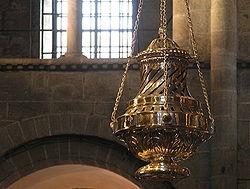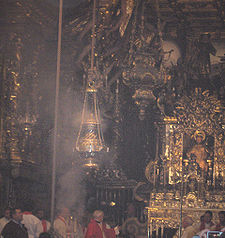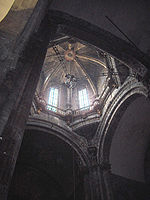
Botafumeiro
Encyclopedia

Thurible
A thurible is a metal censer suspended from chains, in which incense is burned during worship services. It is used in the Catholic Church as well as in Anglican, Eastern Orthodox, Oriental Orthodox, Armenian Apostolic, some Lutheran, Old Catholic, and in various Gnostic Churches. It is also used...
found in the Santiago de Compostela Cathedral
Cathedral of Santiago de Compostela
Santiago de Compostela Cathedral is a Roman Catholic cathedral of the archdiocese of Santiago de Compostela in Galicia, Spain. The cathedral is the reputed burial-place of Saint James the Greater, one of the apostles of Jesus Christ. It is the destination of the Way of St...
(in the past similar devices were used in large churches in Galicia, nowadays sometimes is used in the Tui
Tui, Galicia
Tui , in Spanish Tuy, is a town in Galicia , in the province of Pontevedra. It is located on the left bank of the Minho River, facing the Portuguese town of Valença....
Cathedral). Incense
Incense
Incense is composed of aromatic biotic materials, which release fragrant smoke when burned. The term "incense" refers to the substance itself, rather than to the odor that it produces. It is used in religious ceremonies, ritual purification, aromatherapy, meditation, for creating a mood, and for...
is burned in this swinging metal container, or "incensory
Censer
Censers are any type of vessels made for burning incense. These vessels vary greatly in size, form, and material of construction. They may consist of simple earthenware bowls or fire pots to intricately carved silver or gold vessels, small table top objects a few centimetres tall to as many as...
". The name "Botafumeiro" means "smoke expeller" in Galician
Galician language
Galician is a language of the Western Ibero-Romance branch, spoken in Galicia, an autonomous community located in northwestern Spain, where it is co-official with Castilian Spanish, as well as in border zones of the neighbouring territories of Asturias and Castile and León.Modern Galician and...
.
Description
The Botafumeiro is suspended from a pulley mechanism in the dome on the roof of the church . The current pulley mechanism was installed in 1604.The present Botafumeiro is made of an alloy
Alloy
An alloy is a mixture or metallic solid solution composed of two or more elements. Complete solid solution alloys give single solid phase microstructure, while partial solutions give two or more phases that may or may not be homogeneous in distribution, depending on thermal history...
of brass
Brass
Brass is an alloy of copper and zinc; the proportions of zinc and copper can be varied to create a range of brasses with varying properties.In comparison, bronze is principally an alloy of copper and tin...
and bronze
Bronze
Bronze is a metal alloy consisting primarily of copper, usually with tin as the main additive. It is hard and brittle, and it was particularly significant in antiquity, so much so that the Bronze Age was named after the metal...
and is plated by a very thin 20 micrometre layer of silver
Silver
Silver is a metallic chemical element with the chemical symbol Ag and atomic number 47. A soft, white, lustrous transition metal, it has the highest electrical conductivity of any element and the highest thermal conductivity of any metal...
. The current Botafumeiro was created by the gold and silversmith José Losada in 1851. It has a golden sheen.

Censer
Censers are any type of vessels made for burning incense. These vessels vary greatly in size, form, and material of construction. They may consist of simple earthenware bowls or fire pots to intricately carved silver or gold vessels, small table top objects a few centimetres tall to as many as...
s in the world, weighing 80 kg and measuring 1.60 m in height. It is normally on exhibition in the library of the cathedral, but during certain important religious occasions it is brought to the floor of the cathedral
Cathedral
A cathedral is a Christian church that contains the seat of a bishop...
and attached to ropes hung from the pulley mechanism.
There is another large thurible used in the other masses carried out in the cathedral, called "La Alcachofa" (literally, "The Artichoke") or "La Repollo" (literally, "The Cabbage"). La Alcachofa is a silver-colored metal censer. It was created in 1971 by the sacred art artisans working under the craftsman Luis Molina Acedo.
The ropes typically last about 20 years before they have to be replaced. However, recently a thicker rope than usual was used, and the extra rubbing produced premature wear of the rope. Therefore, this thicker rope had to be replaced sooner than had been expected, in 2004. Before 2004, the ropes were woven from hemp
Hemp
Hemp is mostly used as a name for low tetrahydrocannabinol strains of the plant Cannabis sativa, of fiber and/or oilseed varieties. In modern times, hemp has been used for industrial purposes including paper, textiles, biodegradable plastics, construction, health food and fuel with modest...
, or a type of grass called esparto
Esparto
Esparto, or esparto grass, also known as "halfah grass" or "needle grass", Macrochloa tenacissima and Stipa tenacissima, is a perennial grass grown in northwest Africa and the southern part of the Iberian Peninsula employed for crafts .-Esparto paper:It is also used for fiber production for paper...
, and made in Vigo
Vigo
Vigo is a city and municipality in north-west Spain, in Galicia, situated on the ria of the same name on the Atlantic Ocean.-Population:...
, Spain
Spain
Spain , officially the Kingdom of Spain languages]] under the European Charter for Regional or Minority Languages. In each of these, Spain's official name is as follows:;;;;;;), is a country and member state of the European Union located in southwestern Europe on the Iberian Peninsula...
. Since 2004, a rope made of synthetic material has been used.
Shovels are used to fill the Botafumeiro, or the Alcachofa, with about 40 kg of charcoal and incense. The thurible is tied to the rope with elaborate knots. The censer is pushed initially to start its motion. Eight red-robed tiraboleiros pull the ropes, producing increasingly large oscillations of the censer. The turible's swings almost reach the ceiling of the transept
Transept
For the periodical go to The Transept.A transept is a transverse section, of any building, which lies across the main body of the building. In Christian churches, a transept is an area set crosswise to the nave in a cruciform building in Romanesque and Gothic Christian church architecture...
. The incensory can reach speeds of 68 km/h as it dispenses thick clouds of incense
Incense
Incense is composed of aromatic biotic materials, which release fragrant smoke when burned. The term "incense" refers to the substance itself, rather than to the odor that it produces. It is used in religious ceremonies, ritual purification, aromatherapy, meditation, for creating a mood, and for...
.
At the top of the swing, the Botafumeiro reaches heights of 21 meters. It swings in a 65 meter arc between the Azabachería and Praterias doorways at the ends of the transept. The maximum angle achieved is about 82°. The maximum can be reached after about 17 cycles, and requires about 80 seconds of swinging.
It costs about 250€
Euro
The euro is the official currency of the eurozone: 17 of the 27 member states of the European Union. It is also the currency used by the Institutions of the European Union. The eurozone consists of Austria, Belgium, Cyprus, Estonia, Finland, France, Germany, Greece, Ireland, Italy, Luxembourg,...
for each thurible "performance" at the cathedral. Although this is expensive, the swinging of the thurible is very popular with pilgrims, tourists and visitors.
The Botafumeiro produces large volumes of smoke. This is in accord with the well-known saying in religious circles, "More incense, less nonsense."

Tiraboleiros
The Botafumeiro is carried and swung by eight men in red robes, called tiraboleiros. The term "tiraboleiro" is a GalicianGalician language
Galician is a language of the Western Ibero-Romance branch, spoken in Galicia, an autonomous community located in northwestern Spain, where it is co-official with Castilian Spanish, as well as in border zones of the neighbouring territories of Asturias and Castile and León.Modern Galician and...
derivation from the Latin
Latin
Latin is an Italic language originally spoken in Latium and Ancient Rome. It, along with most European languages, is a descendant of the ancient Proto-Indo-European language. Although it is considered a dead language, a number of scholars and members of the Christian clergy speak it fluently, and...
word "turifer", which means "incense carrier", and from which is derived the English equivalent, "thurifer". This comes from the Latin words "thus", meaning incense, and "fero", meaning "carry". There is a comparable term in Spanish
Spanish language
Spanish , also known as Castilian , is a Romance language in the Ibero-Romance group that evolved from several languages and dialects in central-northern Iberia around the 9th century and gradually spread with the expansion of the Kingdom of Castile into central and southern Iberia during the...
, a "turiferario".
The current chief "tiraboleiro" is Armando Raposo.
History
One tradition has it that the use of a swinging censer in the Santiago de Compostela Cathedral began in the 11th century. Arriving pilgrims were tired and unwashed. It was also believed that incense smoke had a prophylactic effect in the time of plagues and epidemicEpidemic
In epidemiology, an epidemic , occurs when new cases of a certain disease, in a given human population, and during a given period, substantially exceed what is expected based on recent experience...
s. Of course, incense burning is also an important part of the liturgy, being an "oration to God", or form of prayer
Prayer
Prayer is a form of religious practice that seeks to activate a volitional rapport to a deity through deliberate practice. Prayer may be either individual or communal and take place in public or in private. It may involve the use of words or song. When language is used, prayer may take the form of...
.

In the 15th century, France's King Louis XI
Louis XI of France
Louis XI , called the Prudent , was the King of France from 1461 to 1483. He was the son of Charles VII of France and Mary of Anjou, a member of the House of Valois....
(1423–1483) donated money to the cathedral to replace their medieval thurible, which was made of silver. A new silver thurible was put into service in 1554. Unfortunately, this ornate vessel was stolen by Napoleon's troops in April, 1809, during an episode in the Spanish War of Independence (1808–1814). Therefore, the Louis XI censer was replaced by the present less ostentatious Losada thurible in 1851.
After 155 years of use, the Botafumeiro was restored in early 2006 by artisans and craftsmen working under Luis Molina Acedo. They repaired the dents and cracks in the Botafumeiro and then reapplied a 20 micrometre thick plating of silver to the vessel.
Many other cathedrals had similar large thuribles at one time. However, most of the other cathedrals discontinued the use of their swinging censers over the years.
Accidents
There have been a number of accidents that occurred during the swinging of the Botafumeiro over the years. Apparently at one time, the Botafumeiro was attached to the rope with a hook which sometimes became disconnected.One of the most renowned accidents took place during a visit of Princess Catherine of Aragon
Catherine of Aragon
Catherine of Aragon , also known as Katherine or Katharine, was Queen consort of England as the first wife of King Henry VIII of England and Princess of Wales as the wife to Arthur, Prince of Wales...
. She was on a journey to marry the heir to the English throne in 1499 and stopped by the cathedral in Santiago de Compostela
Santiago de Compostela
Santiago de Compostela is the capital of the autonomous community of Galicia, Spain.The city's Cathedral is the destination today, as it has been throughout history, of the important 9th century medieval pilgrimage route, the Way of St. James...
. While it was being swung, the Botafumeiro flew out of the cathedral through the Platerias high window. No one was reported to have been injured on this occasion.
The ropes and other devices securing the Botafumeiro have also failed on May 23, 1622, and more recently in 1925 and July 1937. In 1622, the Botafumeiro fell at the feet of the tiraboleiros. In July 1937, the cords holding the Botafumeiro failed again, and hot coals were spilled on the ground.
Current procedure is to attach the rope to the Botafumeiro with a set of "sailor's knots".
Reported weight of the Botafumeiro
Almost every source reports a different weight of the Botafumeiro. This might be because there are multiple thuribles used in ceremonies at the cathedral, and different weights when the thuribles are empty and full of fuel. For example, one can find reported weights of:- 87 kilograms
- 50 kilograms
- 53 kilograms
- 80 kilograms
- 80 kilograms
- 60 kilograms
- 160 kilograms
and many other weights.
Footnotes and references
- O Botafumeiro: Parametric pumping in the Middle Ages, Juan R. Sanmartín, American Journal of PhysicsAmerican Journal of PhysicsThe American Journal of Physics is a monthly, peer-reviewed scientific journal published by the American Association of Physics Teachers and the American Institute of Physics. The editor is Jan Tobochnik of Kalamazoo College.-Aims and scope:...
, Volume 52, Issue 10, October 1984, pp. 937–945

